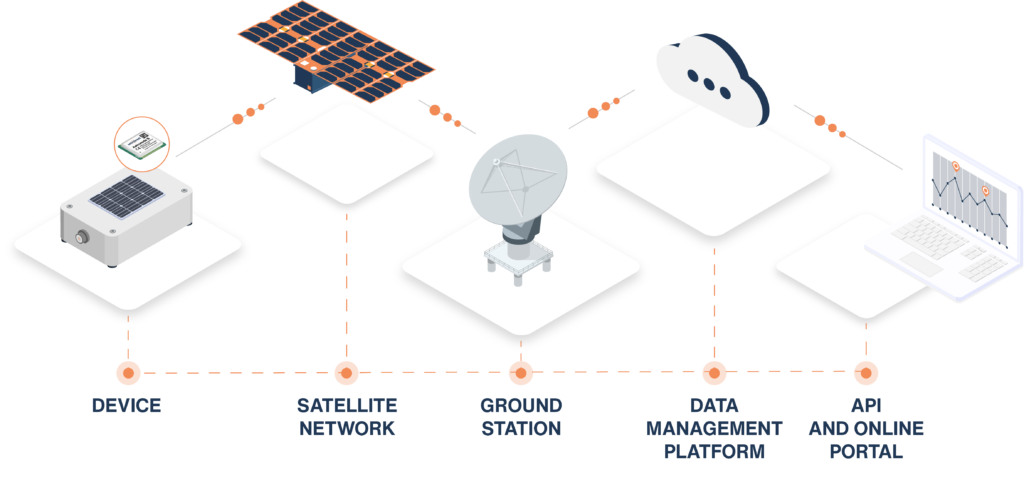Asking IoT sensors new questions: How far can you go?
11 Nov 2021 | 4 min read
IoT sensors provide location, movement, vibration, and environment data, enabling asset tracking, remote monitoring, and data fusi...

For every new IoT project, the selection of the most appropriate network technology is a key topic. There are several wireless connectivity options available. Besides technical criteria like bandwidth, power consumption, etc. implementation cost and security requirements are important aspects. Sometimes, the final decision is not easy and will be taken on a case-by-case basis, driven by the IoT use case to be addressed.
The unique value proposition and key advantage of the Astrocast satellite-based IoT network is a worldwide unlimited coverage: it works everywhere – at surprisingly low cost. For IoT business ideas based on sensors located in no-man’s-land, Astrocast offers an unrivalled solution.
Remote monitoring is a typical IoT application area with IoT devices grabbing relevant local parameters on behalf of a central IoT application. Observed locations are typically not attended and reported IoT data is supposed to provide valuable or actionable information. It might be some customer information like temperature or humidity providing some value, e.g., for travelers. But some other environmental parameters might be critical and require attention by regional authorities (e.g., low water level of a creek). Other open-air environments are observed because they are commercially used like farmland or plantations. Consequently, owners are interested to be aware of local conditions (e.g., doughtiness) in order to optimize growth and yield.
Other economic targets are industrial areas or assets like construction sites, mining equipment, pipelines, or storage facilities without wide-area connectivity. Surveillance, remote control, and predictive maintenance are typical IoT drivers. All these use cases require stationary installations because observed objects do not move, but for an IoT-enabled monitoring you need network coverage at every relevant location. With an Astrocast-enabled solution, flexibility for deployment of IoT sensors is unlimited.
But benefits of a universal global IoT connectivity especially apply to moving objects, esp. if moving paths and final destinations are unknown or uncertain. Some of these asset tracking applications are difficult to put into practice because – even with cellular networks – you cannot rely on network coverage. Absence of tracking data might be acceptable for a limited period of time but will be a major disaster if valuable objects get lost.
Mentioned monitoring and tracking applications are aiming at different use cases at different target locations, but some characteristics are the same: infrequent transmission of small data packages are needed, e.g., a few hundred bytes to be reported by the IoT device every few hours. But on top of existing or obvious IoT applications sharing these typical requirements, many of them have not been unfolded yet because “Everywhere-IoT” was not available before. As a consequence, drowsing business opportunities in deserts, in the mountains, on the open sea or in rural areas are still waiting for discovery… In fact, the major objective of Astrocast is to offer cost-effective IoT services to 85% of the world not covered by cellular systems.
The Astrocast network is based on low-Earth-orbit (LEO) satellites which are orbiting 500 to 550 km from Earth. By nature, uplink transmission of fresh IoT data will have to wait until a friendly satellite passes by. With ten satellites on two orbital planes in early 2022, full constellation with more satellites on more orbits will further decrease uplink latency. In any case, a satellite pass duration of about 2 minutes offers sufficient time for transmission of 500 bytes payload data in multiple messages of 160 bytes each. Each uplink data transmission is acknowledged by the satellite, and if needed, each uplink message can be followed by an 8- or 40-byte downlink message containing user data resp. a control command to be used by the IoT device.
IoT device and transmission data is centrally managed via Astrocast API or the Astrocast Portal. This is where a user or the customer IoT application can interact with the Astrocast network and connected IoT devices – using https commands. By use of this 2-path Astrocast infrastructure (see picture), communication with customer IoT devices becomes bi-directional: IoT data directly via satellite, control commands via Astrocast API.

To take your IoT strategy further and unlock the power of your assets, discover Astrocast’s flexible SatIoT service by joining the Astropreneur Programs today.